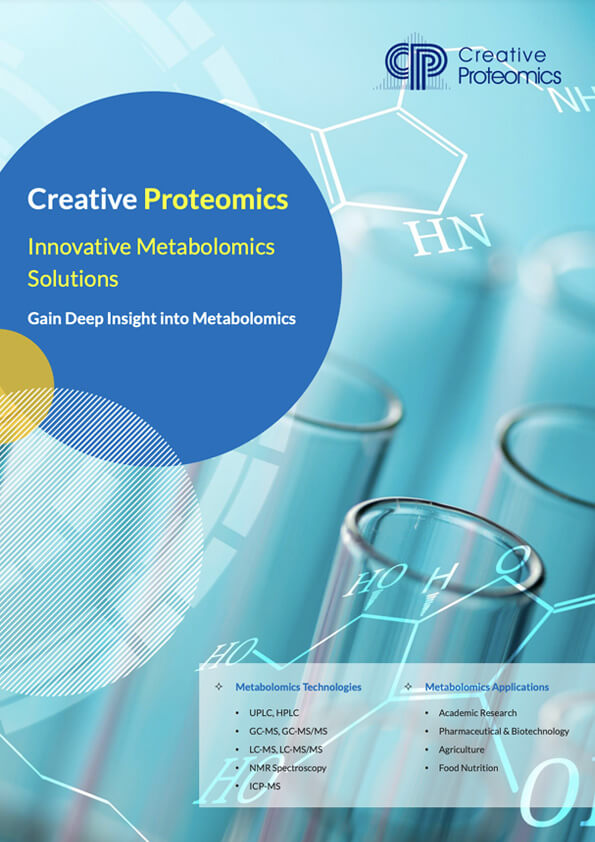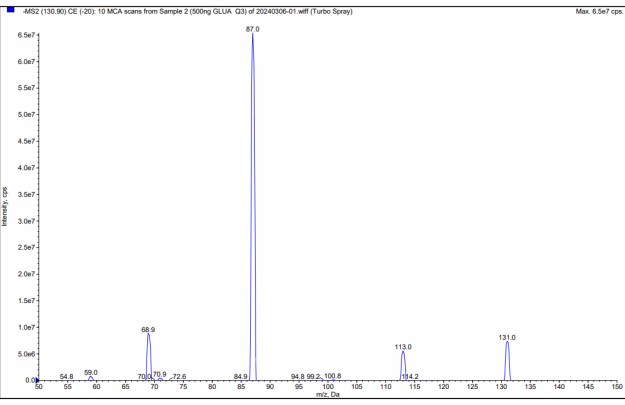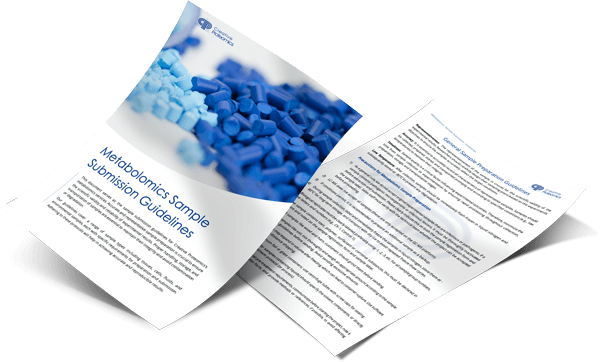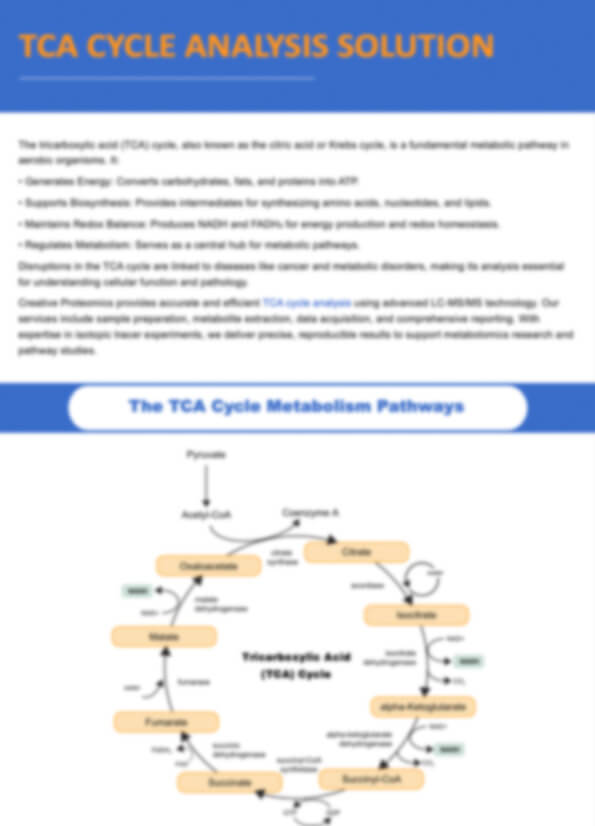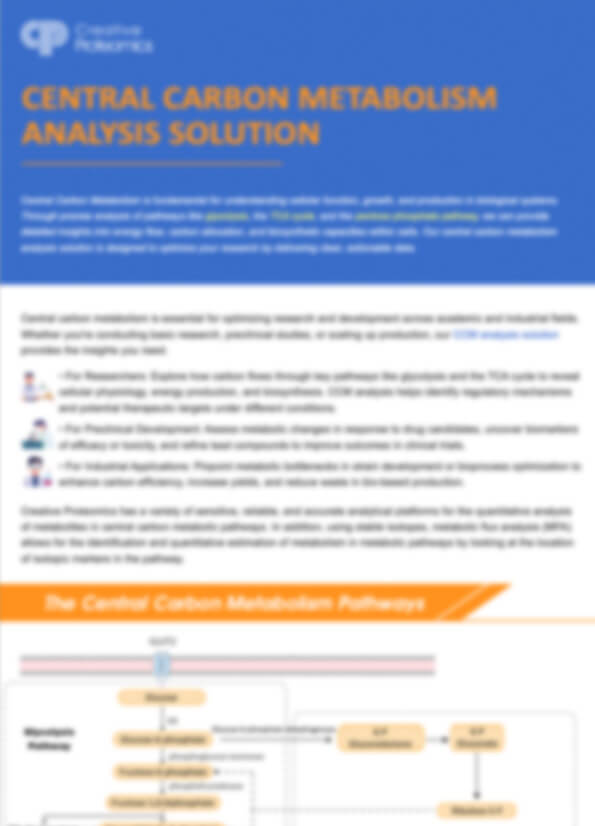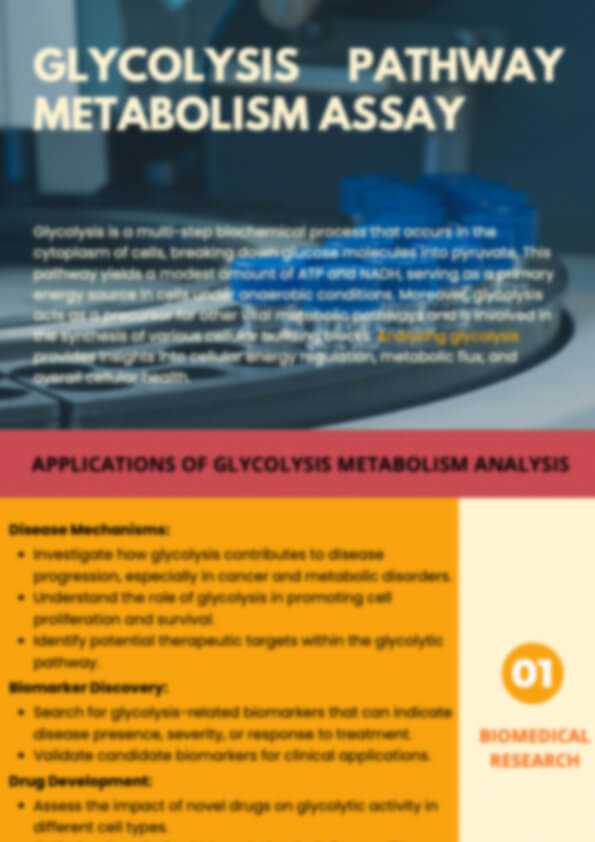Comprehensive Organic Acid Profiling Powered by LC-MS and GC-MS
At Creative Proteomics, we offer validated methods to quantify more than 90 different organic acids using advanced LC-MS and GC-MS platforms. Our analytical workflows support both high-throughput screening and targeted quantification, making them ideal for complex biological and pharmaceutical matrices.
- Exceptional Accuracy
- Ultra-High Sensitivity
- Multi-Analyte Detection
- Dynamic Monitoring Capability
Whether you're studying microbial metabolism, screening biomarkers, or investigating disease pathways, our customizable profiling service delivers actionable data you can trust.
Submit Your Request Now
×- Background
- Methods
- Workflow
- Advantage
- Metabolite Coverage
- Sample Requirement
- OAP+EPP Combo
- FAQ
- Demo
- Case Study
- Publication
What Are Organic Acids?
Organic acids are a group of carbon-based compounds that exhibit acidic properties, most commonly due to the presence of carboxylic acid groups (–COOH). Widely found in both plants and animals, these compounds often exist in the form of salts or esters bound to metal ions such as potassium, sodium, or calcium.
Many organic acids play vital roles in biological metabolism—some act as active intermediates in metabolic pathways, while others serve as bioactive molecules with antibacterial, antiviral, or anti-inflammatory functions. They're also known to enhance calcium and iron absorption, support cardiovascular health, and regulate metabolic balance.
The acidity of organic acids originates from functional groups that can release hydrogen ions (H⁺), such as:
- Carboxyl groups (–COOH)
- Sulfonic acid groups (–SO₃H)
- Phenolic hydroxyl groups (–OH), which contribute weak acidity
The general formula for a carboxylic acid is R–COOH, where "R" represents an organic moiety. Compared to mineral acids, organic acids are typically weaker, only partially dissociating in aqueous solutions. Common examples include citric acid, malic acid, lactic acid, and acetic acid—all widely used in food, medicine, agriculture, and chemical manufacturing.

Categories of Organic Acids
Organic acids can be broadly grouped based on structure and biological role:
1. Carboxylic Acids
Fatty Acids
These long-chain carboxylic acids vary in length and saturation. Examples include:
- Saturated: Palmitic acid (C16), stearic acid (C18)
- Unsaturated: Oleic acid (C18:1), linoleic acid (C18:2), α-linolenic acid (C18:3)
These are critical components of cell membranes and serve as energy reserves.
TCA Cycle Acids
Citric acid, isocitric acid, α-ketoglutaric acid, succinic acid, fumaric acid, and malic acid are key intermediates in the tricarboxylic acid (TCA) cycle, driving cellular energy production.
Other Carboxylic Acids
Lactic acid: Produced during anaerobic respiration, especially in muscle tissue.
Oxalic acid: Common in plants, but high levels in humans can lead to kidney stones.
2. Sulfonic Acids
Taurine, a sulfur-containing non-protein amino acid, supports bile acid metabolism, fluid balance, and antioxidant defense in animals.
3. Phenolic Acids
Compounds like gallic acid, caffeic acid, and ferulic acid contain phenol groups. Found in plant-based foods, they offer antioxidant and anti-inflammatory benefits.
4. Keto Acids
Pyruvic acid: A glycolytic end-product, convertible into lactate or further oxidized in mitochondria.
Acetoacetic acid, β-hydroxybutyric acid: Byproducts of fatty acid metabolism, elevated during ketosis or diabetic ketoacidosis.
Functional Roles of Organic Acids
1. pH Regulation
Organic acids readily donate hydrogen ions, making them valuable pH regulators. In food production, acids like citric and malic acid adjust flavour and inhibit microbial spoilage. In cosmetics, mild organic acids help stabilize formulations and match skin's natural pH.
2. Antioxidant Activity
Phenolic acids, such as gallic and caffeic acids, scavenge free radicals, protecting biomolecules from oxidative damage. These compounds are used as natural preservatives in food and as therapeutic agents to mitigate oxidative stress in chronic diseases.
3. Metal Chelation
Carboxyl and hydroxyl groups can chelate metal ions, forming stable complexes. Applications include:
Agriculture: Enhancing micronutrient uptake (e.g., Fe, Zn, Mn) through soil chelation
Industry: Removing heavy metals during wastewater treatment and refining processes
4. Metabolic Regulation
Organic acids are central to energy metabolism. TCA intermediates like citrate and α-ketoglutarate are critical in nutrient oxidation and ATP generation. Some also act as signaling molecules that modulate gene expression and enzyme activity.
5. Solubilization and Emulsification
Certain organic acids and their esters have surface-active properties. In pharma and cosmetics, they improve the solubility of poorly water-soluble compounds, enhancing formulation stability and efficacy.
6. Antimicrobial Effects
Organic acids like lactic and acetic acid disrupt microbial membranes and inhibit metabolic processes, making them effective natural preservatives. In medicine, they are explored for use in disinfectants and antimicrobial formulations.
How Are Organic Acids Detected?
The detection and quantification of organic acids rely on a range of analytical methods, each suited to specific acid types and concentrations. The most commonly used techniques include ion chromatography (IC), capillary electrophoresis (CE), high-performance liquid chromatography (HPLC), and gas chromatography (GC).
Conventional Methods
- Ion Chromatography & Capillary Electrophoresis
Effective for polycarboxylic and polyhydroxy acids present at high concentrations. These techniques provide good separation for highly polar analytes but are limited by sensitivity. - Gas Chromatography (GC)
Ideal for volatile and semi-volatile acids. However, low-abundance volatile acids (e.g., isobutyric acid, crotonic acid) are difficult to quantify accurately due to instrument sensitivity limits and interference from matrix components.
High-Performance Liquid Chromatography (HPLC)
HPLC remains one of the most widely adopted methods for organic acid detection. Typically, acidic aqueous solutions or buffered salts are used as the mobile phase to suppress ionization, enabling better separation on reverse-phase columns.
However, challenges persist:
- The inherent polarity of organic acids, even under acidic conditions, often leads to poor retention on standard C18 columns.
- High water content in the mobile phase increases the risk of column collapse.
- Structural similarities among organic acids—and interactions with the chromatographic system—can make baseline separation difficult.
- Co-eluting substances in biological samples further complicate analysis.
LC-MS/MS: The Gold Standard for Organic Acid Quantification
Liquid Chromatography–Tandem Mass Spectrometry (LC-MS/MS) combines the separation power of liquid chromatography with the specificity and sensitivity of mass spectrometry. It enables seamless, high-throughput workflows for both qualitative and quantitative organic acid analysis.
Key Advantages
- High Specificity
Chromatographic separation prevents interference from endogenous compounds, isomers, and metabolic by-products, ensuring precise detection. - Ultra-Sensitive Detection
Current LC-MS/MS platforms achieve detection limits as low as 1 pg/mL—10 to 50 times more sensitive than conventional techniques. This is especially beneficial for analyzing trace-level compounds such as female androgens or rare metabolites. - Superior Accuracy
LC-MS/MS is now widely regarded as the gold standard for small molecule detection in biological samples, outperforming immunoassays in specificity and quantification. - Multiplex Capability
A single plasma or serum sample can be analyzed for multiple target compounds simultaneously, making it ideal for hormone profiling, neonatal screening, vitamin panels, and therapeutic drug monitoring.
Our Platform: Triple Quadrupole LC-MS/MS System
Backed by decades of expertise, Creative Proteomics has developed the LC-MS/MS and GC-MS/MS system, equipped with industry-leading innovations:
- Ultra-high pressure linear motor pump
- Active preheating column oven for temperature stability
- Robust ESI source and vacuum interface
- Highly efficient ion optics and stable quadrupole driving system
These features ensure consistent quantification in complex sample matrices—whether you're working in biomedical research, food safety, or environmental analysis.
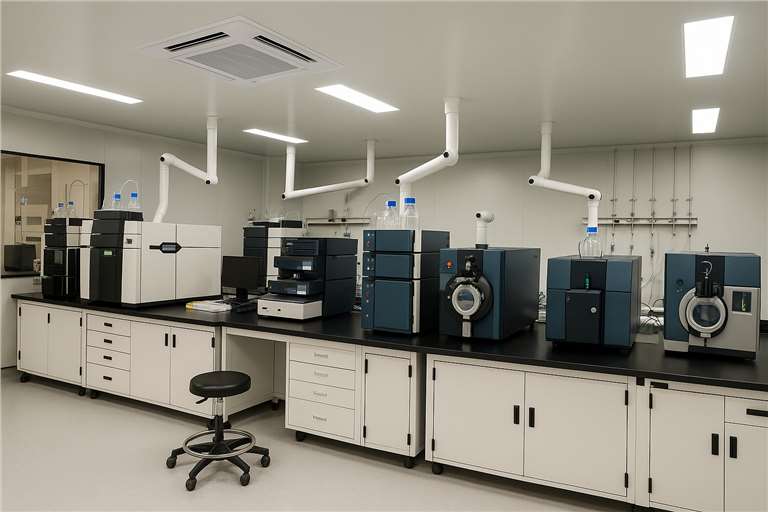
Organic Acid Analysis Workflow
Our metabolomics workflow is structured into two main stages:
1. Experimental Phase
- Experimental design
- Sample preparation
- Metabolite extraction
- Organic acid detection via LC(GC)-MS/MS
2. Data Analysis Phase
- Screening of differential metabolites
- Pathway enrichment and functional analysis
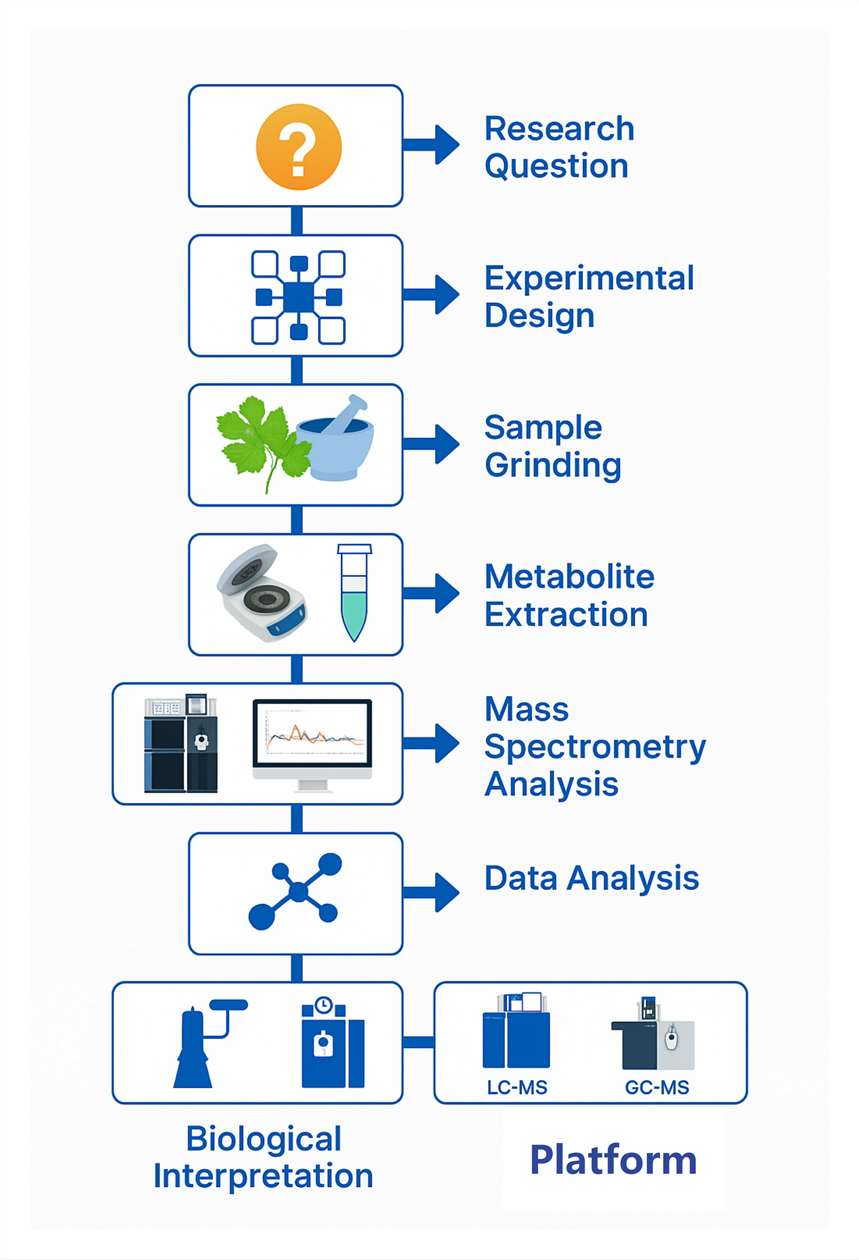 workflow overview
workflow overview
Service Advantages
- Fast turnaround with minimal sample preparation
- High specificity with low background interference
- Cost-effective due to reduced instrumentation demands
- Simultaneous detection of multiple organic acid types
Metabolite Coverage of Organic Acids and Derivatives Analysis Platforms
1. Types of Organic Acids
| Acid Class | Representative Metabolites | Recommended Platform |
|---|---|---|
| Carboxylic Acids | Acetic Acid, Formic Acid, Propanoic Acid, Butyric Acid, Valeric Acid | GC-MS |
| Dicarboxylic Acids | Succinic Acid, Malonic Acid, Glutaric Acid, Adipic Acid, Azelaic Acid, Sebacic Acid | LC-MS / GC-MS |
| Tricarboxylic Acids | Citric Acid, cis-Aconitic Acid, trans-Aconitic Acid, Isocitric Acid | LC-MS |
| α-Keto Acids | Pyruvic Acid, α-Ketoglutaric Acid, Glyoxylic Acid | LC-MS |
| Hydroxy Acids | Lactic Acid, Malic Acid, Glycolic Acid, Tartaric Acid, 3-Hydroxybutyric Acid | LC-MS |
| Aromatic Acids | Benzoic Acid, Cinnamic Acid, Salicylic Acid, Shikimic Acid, Gallic Acid, Phenylacetic Acid | LC-MS |
| Amino Acid Derivatives | 4-Aminobutyric Acid, Pyroglutamic Acid, Kynurenine | LC-MS |
| Phenolic Acids | Ferulic Acid, Caffeic Acid, 4-Coumaric Acid, Hydroxybenzoic Acid | LC-MS |
| Others | Phytic Acid, Humic Acid, Oleanic Acid, Maslinic Acid, Quinic Acid, Oxalic Acid, Fumaric Acid, Isoferulic Acid, isobutyric acid, Maleic Acid | LC-MS |
2. Key Metabolic Pathways Involved
Tricarboxylic Acid (TCA) Cycle
Citric Acid, α-Ketoglutaric Acid, Succinic Acid, Malic Acid, Fumaric Acid, Aconitic Acid
Glycolysis and Energy Metabolism
Pyruvic Acid, Lactic Acid, Acetic Acid, Formic Acid
4-Aminobutyric Acid, Pyroglutamic Acid, Kynurenine
Phenylpropanoid Biosynthesis
Cinnamic Acid, Ferulic Acid, Shikimic Acid, 4-Coumaric Acid, Caffeic Acid
Fatty Acid β-Oxidation & SCFA Metabolism
Butyric Acid, Propanoic Acid, Valeric Acid, Isobutyric Acid, Isovaleric Acid
Polyphenol and Plant Secondary Metabolism
Quinic Acid, Gallic Acid, Hydroxybenzoic Acid
Dicarboxylic Acid Pathway
Malonic Acid, Adipic Acid, Glutaric Acid, Azelaic Acid
Applicable Research Areas
- Plant Nutritional Quality Assessment
- Studies on Plant Growth and Development
- Biotic and Abiotic Stress Response
- Elucidation of Biosynthetic Pathways
Sample Requirements
| Sample type | Recommended sample size | Pre-treatment and storage |
|---|---|---|
| Tissue | 100-200 mg | Snap freezing in liquid nitrogen, stored at -80℃. |
| Urine | 200-500 μL | 5000×g 4℃ Centrifuge for 30-60min, remove supernatant, store at -80℃. |
| Serum/plasma | >100 μL | Collected serum/plasma, snap freezing in liquid nitrogen, stored at -80℃. |
| Cerebrospinal fluid, amniotic fluid, bile and other body fluids | >200 μL | 4℃ Centrifuge for 10min, (or filter using 0.22μm membrane), remove supernatant and store at -80℃. |
| Suspension cells | >1*107 | Centrifuge and collect cells after liquid nitrogen snap freezing and store at -80℃. |
| Walled cells | >1*107 | Cultured walled cells are stored in 1.5ml centrifuge tubes, snap freezing in liquid nitrogen and stored at -80℃. |
| Cell supernatant | >1 mL | centrifuge at 4℃ for 3 minutes, take the supernatant and store at -80℃. |
Delivery
We provide:
- A detailed technical report
- Raw and processed data (Excel or CSV)
- Optional pathway analysis and annotated metabolic maps
- Additional statistical analysis upon request
OAP+EPP Combo: Integrated Profiling of Organic Acids and Functional Biomarkers
Comprehensive Metabolite Analysis for Research Applications
The OAP+EPP Combo combines organic acid profiling (OAP) with functional biomarker analysis (EPP) to deliver a multidimensional view of biochemical status. While OAP offers deep insights into mitochondrial activity, energy pathways, and microbial metabolism, the EPP component expands coverage to include neurotransmitter precursors, detoxification markers, and redox balance indicators.
This integrated platform supports research into metabolic performance, environmental interactions, and cellular homeostasis across diverse biological systems.
1. Glycolysis & Lactic Acid Balance: Indicators of Energy Disruption
Pyruvate and lactate are critical intermediates of the glycolysis pathway. Elevated concentrations may reflect underlying inefficiencies in carbohydrate utilization. At least five known enzyme defects within the glycolytic cascade may lead to accumulation of these intermediates.
Lactate Accumulation: Temporary increases can occur with exercise, but persistently elevated levels may suggest impaired mitochondrial oxidative capacity. Certain environmental agents are known to inhibit mitochondrial ATP synthase, contributing to excess lactate production.
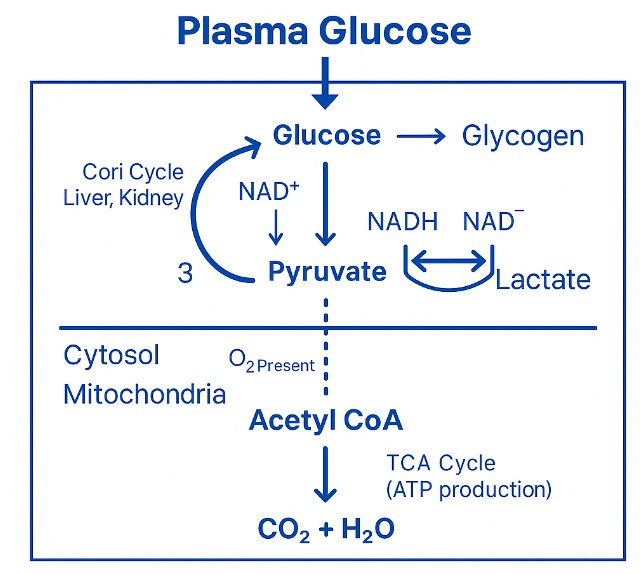
2. Fatty Acid & BCAA Metabolism: Mitochondrial and Ketone Dynamics
Fatty acid oxidation and amino acid catabolism converge at succinyl-CoA, a key intermediate feeding into the TCA cycle.
Elevated Organic Acids: Observed increases may be associated with ketogenic states, prolonged physical exertion, or metabolic enzyme insufficiencies such as those affecting branched-chain amino acid breakdown (e.g., MSUD, BCKA accumulation).
BCAA Dysregulation: While branched-chain amino acids are essential for cellular signaling, elevated levels have been linked to oxidative stress and altered mitochondrial function—factors that may affect metabolic resilience.
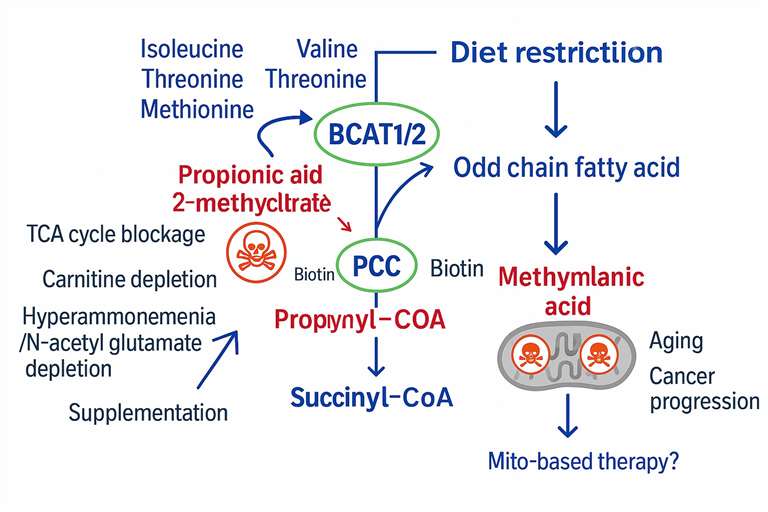
3. Neurotransmitter Pathways: Functional Clues from Metabolic Precursors
Neurotransmitters are synthesized across the central and peripheral nervous systems as well as in peripheral tissues such as the renal system.
Metabolic Correlations: While direct links between CNS neurotransmitters and urinary metabolites continue to be studied, elevated precursors may reflect upstream inefficiencies in synthesis or conversion pathways.
Interpretive Ratios: The vanilmandelate/homovanillate (VMA/HVA) ratio can offer insight into enzymatic activity, including potential alterations in dopamine beta-hydroxylase function.
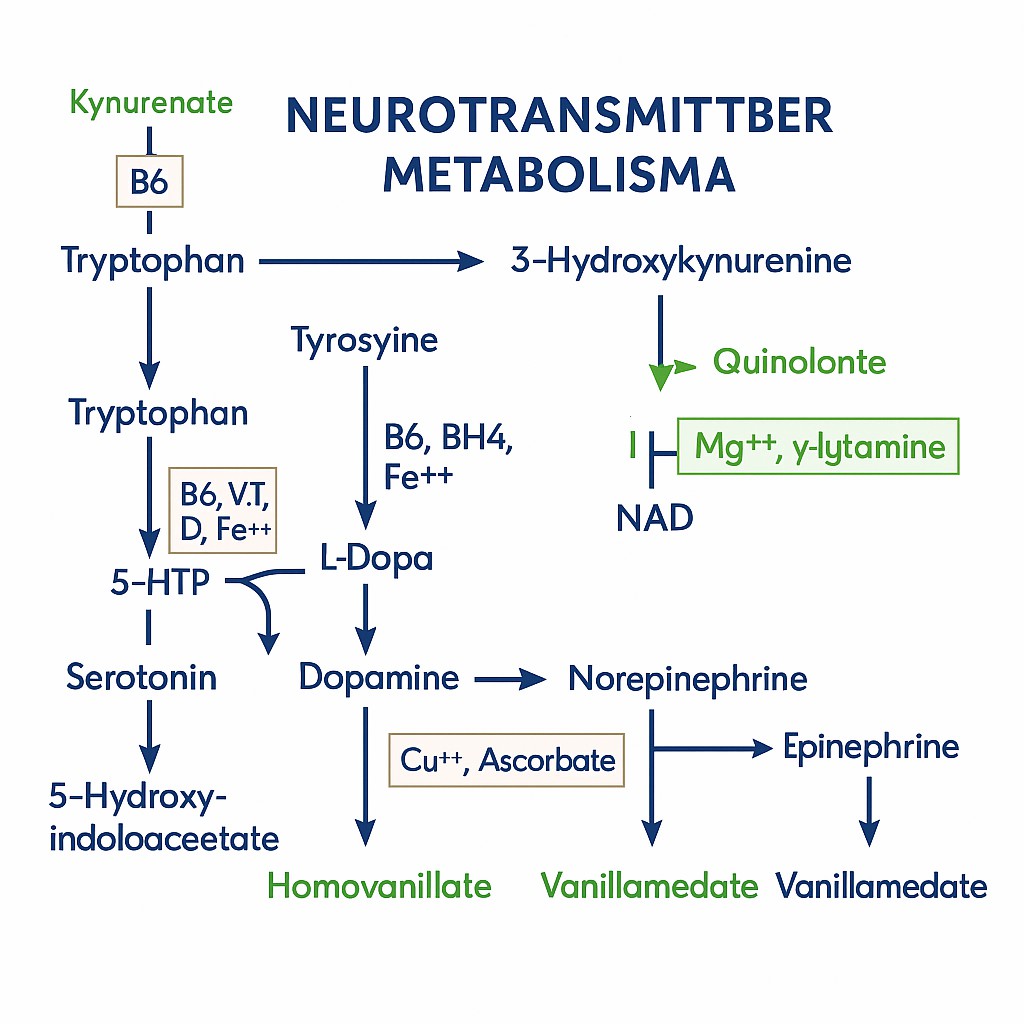
4.Detoxification & Redox Balance: Glutathione Pathway Assessment
Glutathione (GSH) is a central antioxidant molecule composed of glutamate, cysteine, and glycine. It plays a critical role in maintaining redox equilibrium and in cellular detoxification processes.
Pyroglutamic Acid: Elevated levels may be associated with increased oxidative demands or exposure to environmental factors such as mycotoxins]. Glycine limitation may also contribute to inefficient GSH turnover.
Low GSH Output: Markedly low pyroglutamate may reflect suboptimal glutathione synthesis capacity, which could affect cellular tolerance to external stressors].

5. TCA Cycle Intermediates: Core Insights into Cellular Bioenergetics
The tricarboxylic acid (TCA) cycle, or Krebs cycle, is the central route of ATP production in most cells (Figure 5).
Dietary Influence: Intake of citrus fruits has been associated with increased urinary citrate concentrations.
Environmental Stress Response: Certain TCA intermediates may rise in response to lipopolysaccharide (LPS) challenge or environmental compound exposure, serving as markers of cellular adaptation to stress.
6. Bacterial Metabolites: Indicators of Microbial Imbalance
Organic acids also serve as valuable indicators of microbial activity and gut ecosystem shifts.
Overgrowth-Associated Markers: For example, para-hydroxyphenylacetate is commonly elevated in the presence of specific microbial activity, including that of Clostridium difficile, helping researchers identify potential imbalances.
Why Choose the OAP+EPP Combo?
This integrated testing approach provides research teams with a comprehensive metabolomic snapshot, enabling deeper understanding of:
- Energy metabolism and mitochondrial performance
- Neurotransmitter precursor availability and conversion
- Redox and detoxification pathway capacity
- Microbial contributions to metabolic output
Frequently Asked Questions (FAQ)
What types of samples are accepted for organic acid profiling?
We accept a wide range of biological materials, including urine, plasma, serum, tissue homogenates, cell pellets, plant extracts, and microbial cultures. If you're unsure whether your sample is suitable, our technical support team can assist with protocol recommendations.
How should I store and ship my samples?
Samples should be frozen immediately after collection and stored at −80°C. For shipping, use dry ice and insulated containers to ensure sample stability during transit.
Can I analyze both targeted and untargeted organic acids in one run?
Yes. Our LC-MS and GC-MS platforms are optimized for both targeted quantification of known organic acids and untargeted screening for novel or unexpected metabolites.
What are the detection limits of your platform?
Using triple quadrupole LC-MS/MS, we routinely achieve detection limits in the low ng/mL to pg/mL range, allowing sensitive detection even in complex or low-abundance samples.
Can I integrate this service with other omics platforms (e.g., proteomics, transcriptomics)?
Yes. Our OAP+EPP Combo is ideal for integrative multi-omics studies. We can coordinate joint workflows or design modular add-ons tailored to your project goals.
What are the main advantages of combining OAP with EPP analysis?
This combination allows for:
- Simultaneous insights into energy metabolism and neurotransmitter balance
- Tracking redox status and glutathione cycle intermediates
- Detection of microbial metabolites alongside host metabolic markers
This integrated view supports systems-level interpretation in microbiome research, nutrition studies, and toxicology.
Can I request analysis of specific compounds or submit my own target list?
Absolutely. We offer fully customizable panels—whether you're interested in a predefined acid set or need to track niche metabolites (e.g., from a rare pathway or synthetic biology project).
Learn about other Q&A.
Demo
Client Case Study | Uncovering Salt Tolerance Mechanisms in Wild Rice via Untargeted Metabolomics
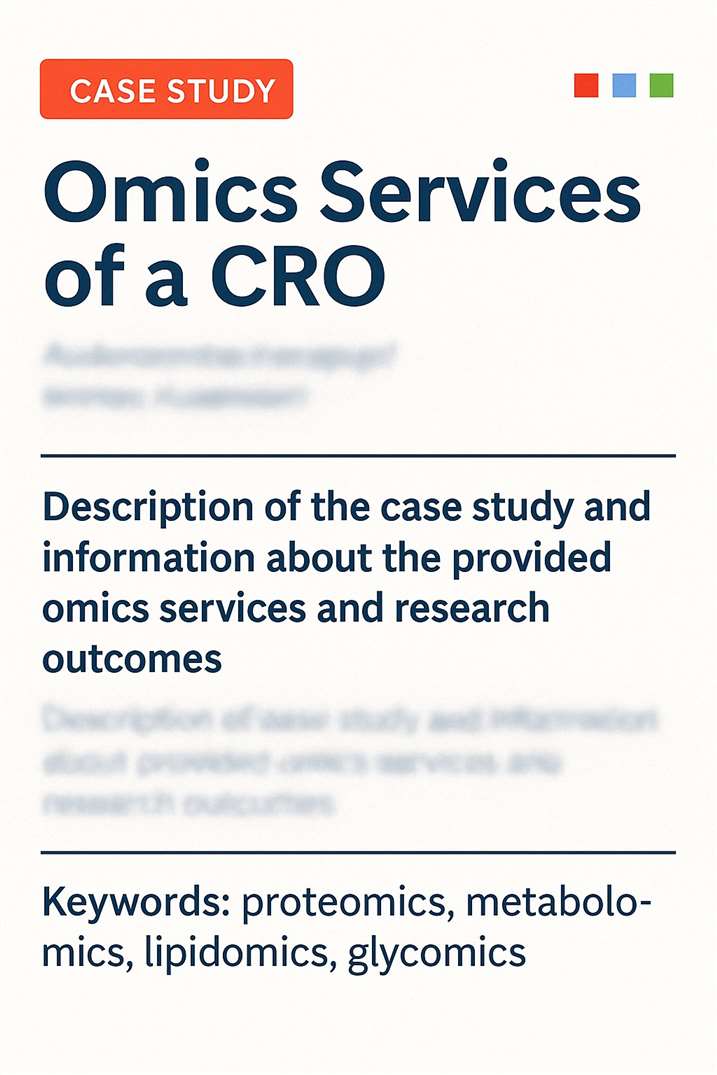
- Background
- Project Objective
- Creative Proteomics’ Services
- Key Findings
Soil salinity is a major threat to global crop production, and cultivated rice (Oryza sativa) is especially salt-sensitive. In contrast, Oryza coarctata, a halophytic wild rice species, can complete its lifecycle in seawater-strength salinity (>400 mM NaCl). To uncover the root-specific biochemical adaptations behind this remarkable resilience, researchers performed untargeted metabolomics profiling of both O. sativa and O. coarctata under control and salt-stressed conditions.
The client aimed to identify key metabolic pathways and biomarkers associated with salt tolerance in O. coarctata roots, using comparative metabolomics as a systems-level approach.
Creative Proteomics provided end-to-end untargeted metabolomics analysis, including:
✅ Sample prep protocol: Extraction guidance optimized for plant root tissues
✅ Advanced LC-MS platform: Thermo Q Exactive plus Orbitrap MS
✅ Dual-mode detection: Both ESI+ and ESI– ionization
✅ Comprehensive data processing: Compound Discoverer + MetaboAnalyst 5.0
✅ Multi-layered statistical interpretation: PCA, volcano plots, pathway enrichment, and lipid heatmaps
Over 1,012 metabolites were detected across all root samples, covering amino acids, lipids, organic acids, and phenylpropanoid derivatives.
- O. coarctata exhibited a constitutive abundance of stress-protective compounds such as vanillic acid, xanthin carotenoids, and branched-chain amino acids even under control conditions.
- Under salt stress, O. sativa upregulated osmotic and oxidative stress-related metabolites as a reactive response, while O. coarctata displayed minimal flux, indicating a pre-adapted metabolic system.
- Lipidomics analysis revealed significant divergence: fatty acyl levels increased in O. coarctata under stress, while phospholipids and glycerolipids were downregulated, suggesting active membrane remodeling.
- Pathway enrichment highlighted arachidonic acid metabolism, cutin/suberin/wax biosynthesis, and phenylpropanoid pathways as major contributors to the halophytic phenotype.
- O. sativa showed stress-induced activation of nicotinate and nicotinamide metabolism
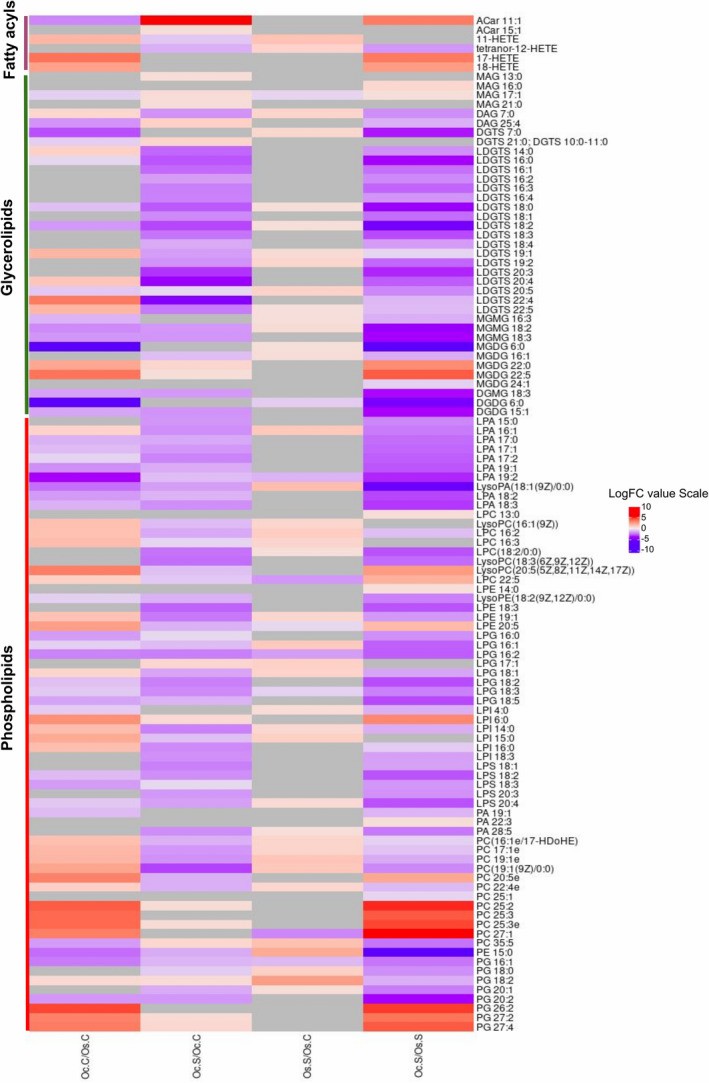 Heatmap of Differentially Expressed Lipids
Heatmap of Differentially Expressed Lipids
Our Organic Acid Profiling Service Review

- The Brain Metabolome Is Modified by Obesity in a Sex-Dependent Manner. International Journal of Molecular Sciences. 2024. https://doi.org/10.3390/ijms25063475
- Comparative Metabolite Profiling of Salt Sensitive Oryza sativa and the Halophytic Wild Rice Oryza coarctata under Salt Stress. Plant‐Environment Interactions. 2024. https://doi.org/10.1002/pei3.10155
- NUDT22 Promotes Cancer Growth Through Pyrimidine Salvage and the TCA Cycle. Oncogene. 2022. https://doi.org/10.21203/rs.3.rs-1491465/v1
- Untargeted Metabolomics Reveal Sex-Specific and Non-Specific Redox-Modulating Metabolites in Kidneys Following Binge Drinking. Redox Experimental Medicine. 2023. https://doi.org/10.1530/REM-23-0005
